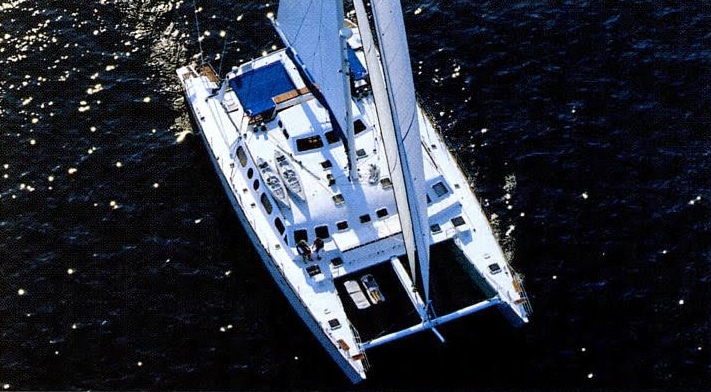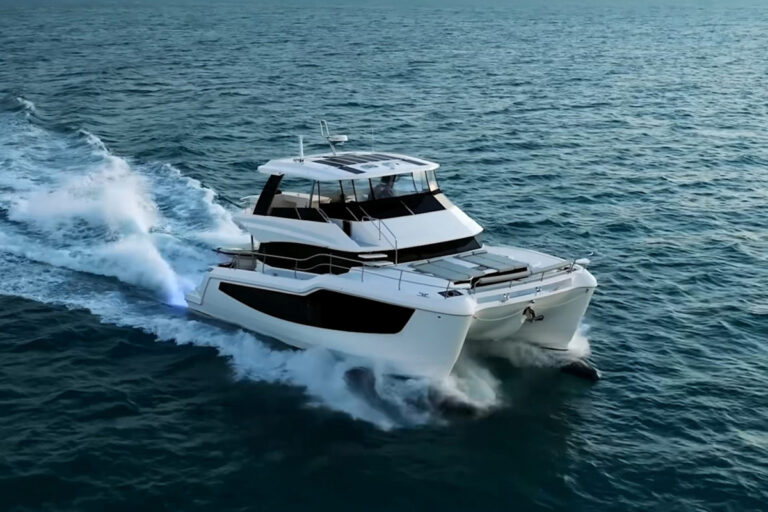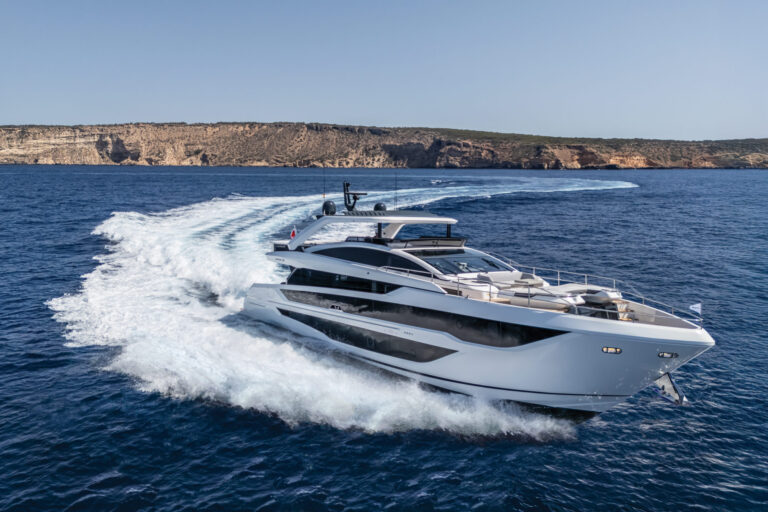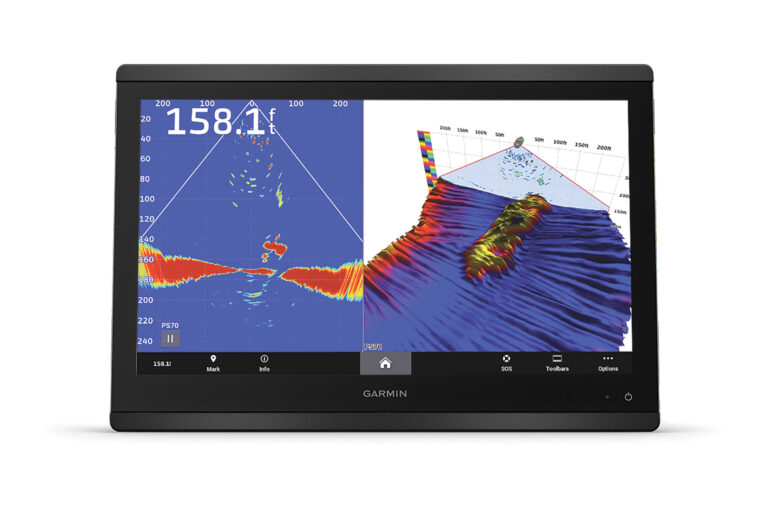
Perspiration soaked my T-shirt and the waistband of my cotton shorts. Volcanic dust painted gaiters on my calves and lined the cuts and scrapes on my knees and thighs. By 10 a.m., I’d climbed more than 800 meters above the Mediterranean, which left me about 100 short of the summit. Sole a Vecchio (Old Sol) had paced me every step of the way, driving the ambient temperature into the middle 90s. The serpentine trail at the lower elevations had tricked me into thinking this was an easy climb. The last third was nearly vertical, and the footing was uncertain in the loose volcanic ash.
I had decided the day before to climb Stromboli, part of the Aeolian Islands off the coast of Italy. We had anchored our charter yacht, the 80-foot sailing cat Blue Moon, a short but prudent distance off the Sciara del Fuoco (trail of fire) on the northwestern flank of the island so we could lunch and watch the crater belch smoke and toss dinghy-size boulders down the mountain.
“Do you want to climb the volcano?” Louis, our skipper, had asked. “There’s a trail leading to the summit from San Bartolo.”
Is the pope Catholic?
That exchange brought me to the beach near the foot of the trail, where Louis had dropped me at 7 a.m. and waited until I cleared the walled-in section of the trail. I’d stopped to wave so he would know I was on the right track. He had returned my wave and sped off in the dinghy. About 30 minutes into the climb, I made a pact with myself to turn back at 10 a.m. if I hadn’t crested the summit.
The witching hour was upon me. Promise or no, I had less than half a liter of water left in my pack, no fruit and a few cookies, which clung to my throat like lumps of quick-dry cement when I tried to eat them. Getting them down required more water than my bottle contained, and I still had three hours of descending. In a fit of rationality, I found a secure flat surface and waited for Stromboli to belch so I could click off the dozen or so frames left on the film in my Canon.
I didn’t have to wait long. The mountain gently shuddered beneath my feet, like the pilothouse sole when you fire up the big diesels. A hollow “boom,” like a distant cannon shot, heaved a puffball cloud of shabby yellow vapor from the mouth of the crater.
“Hhhhhaaaaaa,” the mountain sighed with relief.
No wonder ancient cultures worshipped volcanoes. Stromboli is as alive as you and I, and in spite of the heat, a chill scaled my spine. I reluctantly started down.
Three hours later, wearing a ridiculous grin and shouldering my camera by its 350 millimeter lens, I strode through San Bartolo, looking like PigPen from “Peanuts.” Only the perspiration soaking my body kept a cloud of dust from swirling behind me. As soon as I found an opening to the beach, I waded into the Mediterranean, stopping when the gentle surf skimmed the bottom edges of my shorts. My quads ached and both big toes felt as though they’d been hammered. They had. Full-width bruises had formed at the base of the nails as my feet tried to escape their torture through the toe box of my running shoes. I’d done it, though-climbed that blisteringly hot belching mountain-and I was happy.
I was happy, too, to get back to the comforts of Blue Moon, especially the air conditioning. At 80 feet by 34 feet and about 70 tons displacement, this aluminum cat is really a big fluffy kitten. Toss your seasick preventatives and remedies; her motion is easy. On the other hand, if you love to sail, pray for a fresh breeze. Blue Moon has more wetted surface than her sail area can drive in light air.
She has five double staterooms with a private head in each, giving her a maximum charter capacity of 10 guests. The two staterooms in the port hull are a mirror image of each other and are separated by the heads. The starboard double has twin berths and is right forward of the galley. The two remaining staterooms are on the bridge deck forward of the saloon. All have standing headroom, but the heads in each of the bridge-deck staterooms are a tight fit for anyone more than 5 feet, 7 inches tall. The doorway is narrow, too. I occupied the portside cabin on the bridge deck, and I loved it, but I’m small. The stowage digested my kit and left enough room to stow a fashion plate’s wardrobe. The saloon has the ambience of the family room in a summer cottage, though it doesn’t have enough seating for 10 adults unless they crowd one another a bit. The crew’s quarters are in the bows, accessed via deck hatches.
This big friendly giant of a cat, though, paled before her crew. Skipper Louis Codere knew where to go, what to see and where to eat ashore, and he was more than willing to accommodate each guest’s whims. Our efficient hostess, Nathalie Boen, bearing a gift of knife and fork, could have charmed the Road Runner into Wile E. Coyote’s lair. Chef Jean Francois Rambroul prepared meals of exquisite flavors and presentation. First mate and engineer Jean Baptiste Raignoux was everywhere at once, always available when we needed him to run the dinghy or help with snorkeling gear and kayaks. He did his job without disrupting our routine or compromising our comfort.
Our party met Blue Moon at Portorosa, a relatively new residential complex and marina a short distance from Messina on the island of Sicily. After a quick lunch aboard, we motored to Isola Volcano, about 25 miles, or two hours and 30 minutes, north of Sicily. Volcano is best known for its mud baths, hot springs and the active volcano Gran Cratere. The rim of the crater is about 400 meters high, and a winding trail on its north side ties it to the narrow coastal plain. The round trip, including a circumnavigation of the crater, takes about three hours.
Although this archipelago figures heavily in “The Odyssey” and takes its name from Aeolus, the Greek god of winds, methinks he takes his vacation in August, along with all of Italy and much of the rest of Western Europe. So we motored from Volcano to Lipari, the largest and most populated of the Aeolians. It’s also the capital of the archipelago. Settled by peoples from the Near East in the fourth millennium B.C., Lipari flourished under Greek rule until 252 B.C., when the Romans took control. The Normans followed the Romans, founding the Benedictine church and building the Cathedral of San Bartolomeo on the site of the Roman city. Lipari prospered on the export of sulfur, alum and pumice, but like all good things, the prosperity ended. In 1544, the Tunisian pirate Barbarosa destroyed the civilization, and the island wasn’t fit for habitation until the Spanish took control some years later. The town of Lipari as we know it today developed in the 18th century along Corso Vittorio Emanuele, a few blocks inland and up from the Castello and the Duomo.
Quite a lot of the town of Lipari is a pedestrian mall set off from auto traffic by short stylized pillars embedded in the ciottolato (cobblestone) pavement. During the afternoon, streams of Italian tourists of all ages, many dressed in swim trunks and thong bikinis, strolled the streets at the random pace of leisure. As dark as roasted coffee beans from the intense Mediterranean sun, entire families filtered in and out of shops looking for the perfect souvenir. Al-though highly animated conversations boxed one another in the momentarily empty spaces among the masses, the streets seemed almost quiet, devoid as they were of the motorscooters’ angry buzz. Occasionally, a word or two of a Germanic language joined the mix, and the source stood out like a single light in a cave. I simply looked for the white (or lobster red) skin and blond hair.
At Louis’ recommendation, I climbed the steep stone stairway to the archaeological park on the grounds of the Castello, which overlooks the harbor. This is the site of the ancient walled city, and the digs contain remnants of the original buildings. I also found Greek tombs made of stone and meant to remain above ground. A small cartelloni (placard) at each dig site identifies and dates it. This degree of antiquity is enough to humble the most arrogant specimen of modern mankind.
As much as everyone liked the cosmopolitan atmosphere in Lipari, and as much as I loved Stromboli, all of us truly wished to remain on Panarea. It’s 3 kilometers long by about 1 kilometer wide and distressingly charming. We anchored off San Pietro, the only village of any size and the only one on the island with shops and a small harbor. Many of the restaurants and shops snuggle right up to the waterfront, and during the vacation season stay open late. Several of us sat around a small table opposite the quay, sipping wine and limoncello well into the morning. We’d had dinner ashore at Ristorante Da Pina several stories above the waterfront, and we couldn’t pry ourselves away from the soft night air and frenetic merrymaking.
Earlier that day, we’d anchored northeast of Panarea at Lisca Bianca, one of the rock outcroppings known as Panarelli. Vertical grottoes of swirling rock formations attracted dozens of boats, each loaded to the max with Italian vacationers. Some swam, some snorkeled, some merely lounged on deck in the sun. I launched one of the kayaks and circumnavigated the Lisca Bianca, marveling at the clarity of the water. In many places, I could see to depths of about 10 meters. Along the top of the stacks, centuries of erosion have sculpted sharp, jagged spikes, and I couldn’t help imagining being forced to walk barefoot from one end to the other as a kind of penance for the indiscretions of my past.
Leaving is always the hardest part of a charter. I almost always become attached to the area, the boat, the crew, the food. Will I ever forget the dinner of dorado over zucchini with squash flower stuffed with herbs and ricotta, or Jean Francois’ dessert of baked fresh figs in a balsamic sauce with caramelized sugar formed into a thin wafer over the top?
Not likely.
Contact: Cox Marine, (401) 845-9777; fax (401) 845-2666; cox-marine@edgenet.net, or any charter broker. Blue Moon charters for $28,000 per week for 10 guests, plus expenses.







